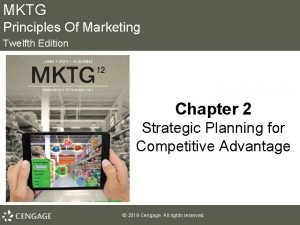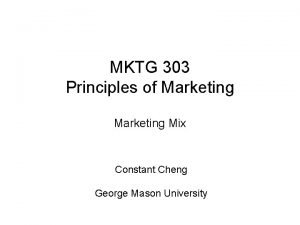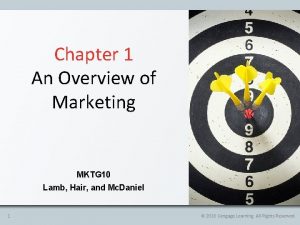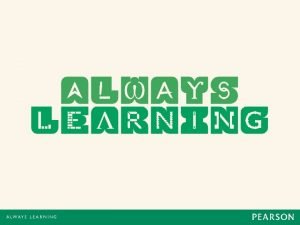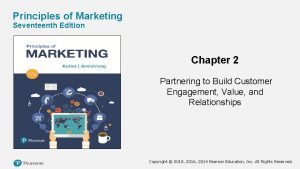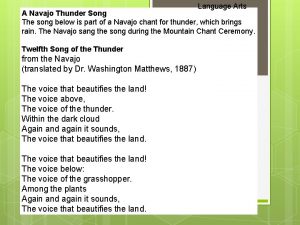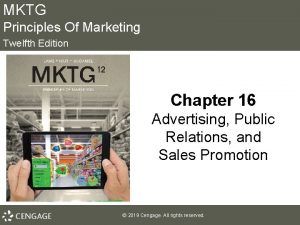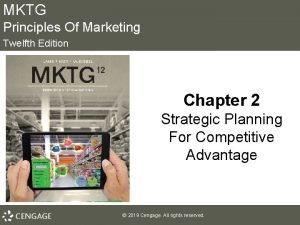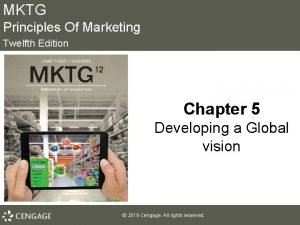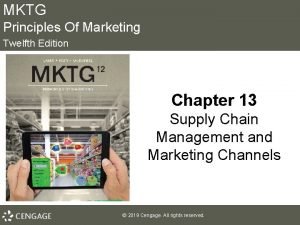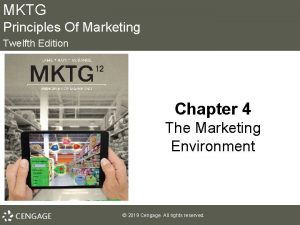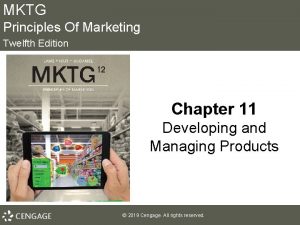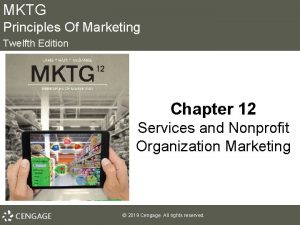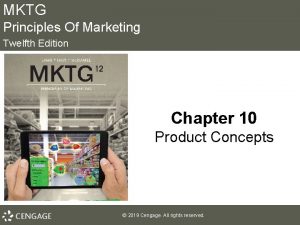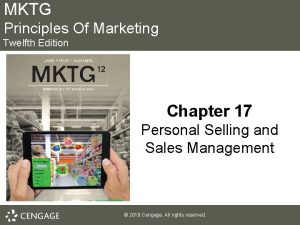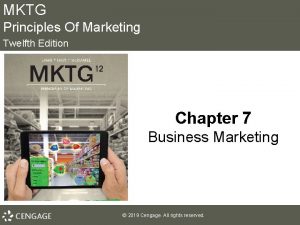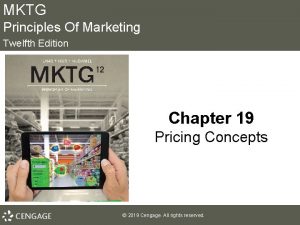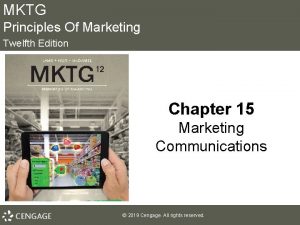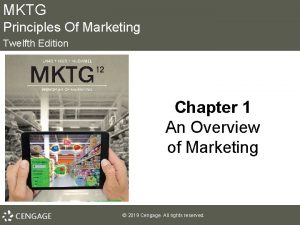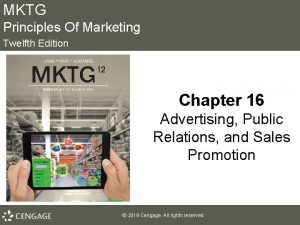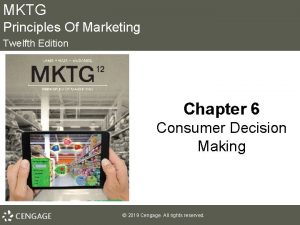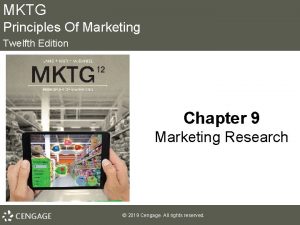MKTG Principles Of Marketing Twelfth Edition Chapter 1


























- Slides: 26

MKTG Principles Of Marketing Twelfth Edition Chapter 1 An Overview of Marketing © 2019 Cengage. All rights reserved.

Learning Outcomes 1 -1 1 -2 1 -3 1 -4 Define the term marketing Describe four marketing management philosophies Discuss the differences between sales and market orientations Describe several reasons for studying marketing © 2019 Cengage. All rights reserved.

What is Marketing? (slide 1 of 2) • Marketing: the activity, set of institutions, and processes for creating, communicating, delivering, and exchanging offerings that have value for customers, clients, partners, and society at large – • American Marketing Association (AMA)’s definition Has two facets – – It is a philosophy, an attitude, a perspective, or a management orientation that stresses customer satisfaction It is an organization function and a set of processes used to implement this philosophy © 2019 Cengage. All rights reserved.

What is Marketing? (slide 2 of 2) • • Exchange: people giving up something in order to receive something else they would rather have Conditions for an exchange: – – – At least two parties must be involved Something of value must be present Parties are capable of communication and delivery Each party is free to accept or reject the offer Desire to deal with the other party exists © 2019 Cengage. All rights reserved.

Marketing Management Philosophies • Four competing philosophies strongly influence an organization’s marketing processes – – Production orientation Sales orientation Market orientation Societal marketing orientation © 2019 Cengage. All rights reserved.

Production Orientation • Production orientation: a philosophy that focuses on the internal capabilities of the firm rather than on the desires and needs of the marketplace – Management assesses its resources and asks questions regarding their strengths and capabilities – Does not consider if the goods and services produced by the firm meets the needs of the marketplace – Product-oriented firms can survive if competition is weak or demand exceeds supply • What can we make or do best? © 2019 Cengage. All rights reserved.

Sales Orientation • Sales orientation: the belief that people will buy more goods and services if aggressive sales techniques are used and that high sales result in high profits – Sales-oriented firms believe marketing is selling things and collecting money – These firms lack understanding of the needs and wants of the marketplace. – Firms often cannot convince people to buy what is neither wanted nor needed despite the quality of sales force. • How can we sell more aggressively? © 2019 Cengage. All rights reserved.

Market Orientation (slide 1 of 2) • Marketing concept: the idea that the social and economic justification for an organization’s existence is the satisfaction of customer wants and needs while meeting organizational objectives – Focusing on customer wants and needs to distinguish products from competitors’ offerings – Integrating all the organization’s activities to satisfy customer wants – Achieving the organization’s long-term goals by satisfying customer wants and needs legally and responsibly • Market orientation: a philosophy that assumes that a sale does not depend on an aggressive sales force but rather on a customer’s decision to purchase a product; it is synonymous with the marketing concept © 2019 Cengage. All rights reserved.

Market Orientation (slide 2 of 2) • Firms with a market orientation assume that a sale does not depend on an aggressive sales force but rather on a customer’s decision to purchase a product • Achieving a market orientation involves: – Obtaining information about customers, competitors, and markets – Examining the information from a total business perspective – Determining how to deliver superior customer value – Implementing actions to provide value to customers • What do customers want and need? © 2019 Cengage. All rights reserved.

Societal Marketing Orientation • Societal marketing orientation: the idea that an organization exists not only to satisfy customer wants and needs and to meet organizational objectives but also to preserve of enhance individuals’ long-term best interests – Acknowledges that some products that customers want may not be in their best interests or of society as a whole • What do customers want and need, and how can we benefit society? © 2019 Cengage. All rights reserved.

Discussion Point Marketing Management Philosophies • Read the following examples: – Henry Ford’s Model T available in any color—as long as it is black – The Body Shop – Ritz Carlton hotels – Dot. com businesses in the late 1990 s – Method cleaning products – Coach Determine which type of marketing management philosophies are described: production, sales, market, or societal marketing orientation. © 2019 Cengage. All rights reserved.

Who Is in Charge? • The Internet and social media have accelerated the shift in power from manufacturers and retailers to consumers and business users • A. G. Laffey concludes that “the customer is boss” • Companies must create strategy by offering distinct and compelling customer value and accomplish this by carefully studying customers and using deep market insights © 2019 Cengage. All rights reserved.

The Organization’s Focus • Historic sources of competitive advantage— technology, innovation, economies of scale—allowed companies to focus their efforts internally and prosper. • Today, many successful firms derive their competitive advantage from an external, market-oriented focus. © 2019 Cengage. All rights reserved.

Customer Value • Customer value: the relationship between benefits and the sacrifice necessary to obtain those benefits – Price is a component of value, low price is not the same as good values – Consumers of all markets and all income levels look for value © 2019 Cengage. All rights reserved.

Customer Satisfaction • Customer satisfaction: customers’ evaluation of a good or service in terms of whether that good or service has met their needs and expectations – The culture of companies that emphasize customer satisfaction focus on delighting customers rather than selling products – To improve customer satisfaction, companies can: § Change from a decentralized, part-time customer service group into a full-time, centralized customer service team § Offer customers what they need © 2019 Cengage. All rights reserved.

Building Relationships (slide 1 of 2) • Relationship marketing: a strategy that focuses on keeping and improving relationships with current customers • Successful relationship marketing strategies depend upon: – Customer-oriented personnel – Effective training programs – Employees with the authority to make decisions and solve problems – Teamwork © 2019 Cengage. All rights reserved.

Building Relationships (slide 2 of 2) • Empowerment: delegation of authority to solve customers’ problems quickly—usually by the first person the customer notifies regarding a problem • Teamwork: collaborative efforts of people to accomplish common objectives © 2019 Cengage. All rights reserved.

Discussion Point Empowerment • What jobs have you held where you were empowered? What were you permitted to do in order to satisfy the customer? How did being empowered make you feel? © 2019 Cengage. All rights reserved.

The Firm’s Business • Answering the question “What is this firm’s business? ” in terms of the benefits customers seek, instead of goods and services, offers at least three important advantages: – Ensures firm’s focus on customers – Encourages innovation and creativity – Stimulates an awareness of change in customer preferences • Sales-oriented firms may miss opportunities to serve customers whose wants can be met through a wide range of product offerings instead of through specific products © 2019 Cengage. All rights reserved.

Customer Relationship Management (CRM) • Customer relationship management (CRM): a company -wide business strategy designed to optimize profitability, revenue, and customer satisfaction by focusing on highly defined and precise customer groups – – Organize company around customer segments Establish and track customer interactions with the company Foster customer-satisfying behaviors Link all processes of the company from its customers through its suppliers • On-demand marketing: delivering relevant experiences, integrated across both physical and virtual environments, throughout the consumer’s decision and buying process © 2019 Cengage. All rights reserved.

The Firm’s Primary Goal • Sales-oriented organizations – Seek to achieve profitability through sales volume – Make a profit by creating customer value, providing customer satisfaction, and building long-term relationships with customers • Market-oriented organizations – Make a profit by creating customer value, providing customer satisfaction, and building long-term relationships with customers © 2019 Cengage. All rights reserved.

Tools the Organization Uses to Achieve Its Goals • Sales-oriented organizations – Seek to generate sales volume through intensive promotional activities • Market-oriented organizations – Recognize that promotion decisions are only one of four basic marketing mix decisions that must be made © 2019 Cengage. All rights reserved.

A Word of Caution • Comparing sales and market orientations is not meant to minimize the role of promotion – Promotion is the means by which organizations communicate with present and prospective customers about the merits and characteristics of their organization and products – Effective promotion is an essential part of effective marketing – Salespeople are problem solvers and important links to supply sources and new products © 2019 Cengage. All rights reserved.

Why Study Marketing? • Marketing affects you every day – Plays an important role in society – Important to Business – Good Career Opportunities © 2019 Cengage. All rights reserved.

Key Terms (slide 1 of 2) • • Marketing Exchange Production orientation Sales orientation Marketing concept Market orientation Societal marketing orientation Customer value © 2019 Cengage. All rights reserved.

Key Terms (slide 2 of 2) • • • Customer satisfaction Relationship marketing Empowerment Teamwork Customer relationship management(CRM) On-demand marketing © 2019 Cengage. All rights reserved.
 Mktg 12 principles of marketing
Mktg 12 principles of marketing Principles of marketing chapter 1
Principles of marketing chapter 1 Principles of marketing chapter 9
Principles of marketing chapter 9 Ricky w griffin management 12th edition
Ricky w griffin management 12th edition Bases for market segmentation
Bases for market segmentation Mktg emc
Mktg emc Chapter 2 sports and entertainment marketing
Chapter 2 sports and entertainment marketing Cheng, constant
Cheng, constant Mktg 10
Mktg 10 Principles of marketing fifth european edition
Principles of marketing fifth european edition Marketing management (arab world edition) philip kotler
Marketing management (arab world edition) philip kotler Principles of marketing chapter 2
Principles of marketing chapter 2 Principles of marketing module 2
Principles of marketing module 2 Using mis (10th edition) 10th edition
Using mis (10th edition) 10th edition Zulily case study
Zulily case study One face one voice one habit and two persons
One face one voice one habit and two persons Twelfth night ppt
Twelfth night ppt Daylight and champaign discovers not more
Daylight and champaign discovers not more Themes in twelfth night
Themes in twelfth night Dramatic techniques in twelfth night
Dramatic techniques in twelfth night Twelfth night act 1 summary
Twelfth night act 1 summary Duke orsino
Duke orsino Themes in twelfth night
Themes in twelfth night Language
Language Twelfth night act 5
Twelfth night act 5 Setting of twelfth night
Setting of twelfth night A man lives on the twelfth floor of a tall building
A man lives on the twelfth floor of a tall building
